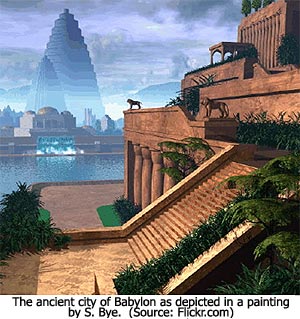“Mystery Babylon”
New York, Rome, or Babylon?

Whenever a war breaks out in the Middle East, prophetic speculation always shifts into high gear, and that is understandable since end time Bible prophecy focuses on the Middle East and mentions several wars that will take place there.
End Time Wars
The first question seems always to be whether or not the war is the War of Armageddon. I guess this question is a natural one because this is the prophetic war that people have heard the most about. But that war is one that will occur at the end of the Tribulation, following a seven year period of unparalleled destruction on the earth.
Actually it is a misnomer to refer to a “War of Armageddon” since it does not involve a clash of armies. Rather, the Antichrist and his forces, who will be gathered in the Valley of Armageddon for battle, will be supernaturally destroyed by Jesus when He returns to the Mount of Olives. He will speak a word, and they will be devoured by a supernatural plague (Zechariah 14:12 and 2 Thessalonians 2:8).
Those who are more familiar with Bible prophecy often speculate as to whether any new war in the Middle East might be the War of Gog and Magog. Actually, Bible prophecy talks about two wars of Gog and Magog. One is associated with the Tribulation; the other with the Millennium.
The one affiliated with the Tribulation is the war described in Ezekiel 38 and 39. This war consists of a Russian coalition of Islamic nations that invades Israel and is supernaturally destroyed by God (Ezekiel 38:18-22 and 39:1-6).1

The other War of Gog and Magog occurs at the end of the Millennium when once again the peoples of Russia rally the whole world to attack the throne of Jesus in Jerusalem. The nations that join this revolt are also supernaturally destroyed (Revelation 20:7-10).
Speculations Prompted by the War in Iraq
Sometimes the speculation about end time wars becomes bizarre. For example, I was astonished to hear one of the best known teachers of Bible prophecy propose a new theory when the United States attacked Iraq. He argued that the war was a fulfillment of a prophecy in Jeremiah 50:9-10 which reads as follows:
“For behold, I am going to arouse and bring up against Babylon a horde of great nations from the land of the north, and they will draw up their battle lines against her; from there she will be taken captive. Their arrows will be like an expert warrior… and Chaldea will become plunder…”
The first problem with this interpretation is that it violates the context in which the passage is found. That context is the destruction of the Antichrist’s kingdom that will take place at the end of the Tribulation. The second problem is that the U.S. led coalition was anything but a “horde of great nations.” We had three allies who supplied combat troops: England, Australia, and Poland. And the invasion certainly did not come from the north. It came out of Kuwait, from the southeast.
Incredibly, this prophecy teacher, who was determined to force this passage on the War in Iraq, tried to argue that the invasion really came from the north because, as he put it, “If you will check the latitude line that runs through Baghdad, you will find that it is the same one that runs through Savannah, Georgia, and thus the majority of the United States lies north of Baghdad.” To say the least, I was dumbfounded by this lame attempt to twist the Scriptures to fit this teacher’s preconceived idea.
The most popular new speculation that I found all over the Internet at the time the Iraqi War began was one that argued the United States is Babylon and would therefore experience an overwhelming defeat in Iraq in accordance with the prophecies contained in Isaiah 13 and 14 and Jeremiah 50 and 51, all of which say Babylon will be destroyed in the end times. The outcome of the war put an end to this speculation.
A more credible speculation that many outstanding Bible prophecy teachers proposed was that the war in Iraq would lead to the destruction of Baghdad and the subsequent rise of Babylon as the new capital of Iraq. They then proposed that this rebuilt Babylon would become the international headquarters of the Antichrist kingdom. This speculation also failed to materialize because of the precision bombing that was aimed almost exclusively at military targets.
Speculation About Babylon
Because of the war in Iraq, there has been much speculation in recent years about the possible rebuilding of ancient Babylon. Actually some of the speculation preceded the war and was based on the fact that Saddam Hussein began rebuilding Nebuchadnezzar’s palace in order to stimulate tourism.
Prior to this century, the consensus of opinion among Bible prophecy experts was that the “Mystery Babylon” of Revelation 17 and the “Babylon the Great” of Revelation 18 were both references to Rome. Today, that opinion has radically shifted, and the consensus now is that these terms refer to ancient Babylon. Accordingly, these experts argue that Babylon will soon be rebuilt.
The speculation that the end time “Babylon the Great” of Revelation 18 will be ancient Babylon rebuilt is biblically based. This is the reason that Tim LaHaye, in his “Left Behind” series of books, presents Babylon as the capital city of the Antichrist’s world kingdom.
Let’s take a look at the biblical basis of this assumption. It begins in the Hebrew Scriptures in Isaiah 13 where the prophet says that Babylon will be destroyed in “the day of the Lord” (Isaiah 13:6, 9). This terminology is a clear reference to the end times and, of course, Babylon can not be destroyed unless it is rebuilt.
Isaiah 14:1-17 says that the king of Babylon at the time of its end time destruction will be an oppressor of unparalleled ruthlessness. This is an image that certainly brings to mind the Antichrist.
The book of Revelation in the New Testament confirms these Old Testament prophecies. Revelation 17 associates the end time apostate world religion with Babylon. And in a similar manner, Revelation 18 associates the political empire of the Antichrist with Babylon.
Consider Revelation 18:1-10. This passage clearly teaches that Babylon will be the capital city of the Antichrist and that at the end of the Tribulation, the city will be destroyed in one hour of one day (Revelation 18:8,10).
Now, in view of these biblical passages from both the Old and New Testaments, you might wonder how anyone who takes Bible prophecy seriously could doubt that Babylon will be rebuilt and serve as the seat of power of the Antichrist. Yet, there are many outstanding Bible prophecy teachers, like Dave Hunt and Ed Hindson, who argue that Babylon will never be rebuilt and that the world headquarters of the Antichrist will be Rome.
The Argument for Rome
Let’s take a look at the other side of the argument — that the Babylon of the end times will really be modern day Rome.
There are two reasons that are usually given as to why the end time Babylon may not be the Babylon of Iraq:
1) The Bible indicates that after Babylon is conquered by the Medes, it will become a heap of ruins and will never be rebuilt again.
2) There is strong evidence that Babylon is used symbolically in the book of Revelation to refer to Rome.
The Conquest by the Medes
With regard to Babylon being destroyed and never being rebuilt again, let’s take a look at Isaiah 13:17-20 —
) Behold, I am going to stir up the Medes against them [the Chaldeans]…
19) And Babylon, the beauty of kingdoms, the glory of the Chaldean’s pride, will be as when God overthrew Sodom and Gomorrah.
20) It will never be inhabited or lived in from generation to generation.
This passage prophesies that Babylon will be overthrown by the Medes and that it will thereafter become a desolation, like the location of Sodom and Gomorrah. A similar passage can be found in Jeremiah 51:11.
Those who argue for the rebuilding of Babylon discount this passage for several reasons. First, they argue it is an end time prophecy referring to the destruction of Babylon at the end of the Tribulation.
But this simply is not true. The context is clearly speaking of the conquest of Babylon by the Medes. There certainly are end time prophecies about Babylon in Isaiah 13, but this is not one of them. End time prophecies are often mixed with contemporary prophecies. For example, in Luke 21 some of the prophecies about the destruction of Jerusalem pertain to 70 AD, whereas others refer to the end times.
Also, in Jeremiah 25:11 there is a prophecy that clearly links the desolation of Babylon to its overthrow by the Medes: “‘Then it will be when seventy years [of Jewish captivity in Babylon] are completed. I will punish the king of Babylon and that nation,’ declares the Lord, ‘for their iniquity, and the land of the Chaldeans; and I will make it an everlasting desolation.'”
Those who advocate the rebuilding of ancient Babylon usually ignore these passages that link the everlasting desolation of the city to the conquest by the Medes.
The only advocate I have seen deal with the problem did so by asserting that the reference to the Medes is really a reference to modern day Kurds who will join with a multinational force that will destroy Babylon.2 But Babylon was conquered by the Medes, just as these prophecies said it would be, and any effort to spiritualize the prophecies to refer to modern day Kurds seems to me to be a violation of the clear meaning of the prophecies.
The Comparison with Sodom and Gomorrah
The second way people try to discount the clear meaning of Isaiah 13:17-20 is to argue that it could not refer to the Medes’ conquest of Babylon because that victory was so surprising and swift that it did not result in the destruction of the city. They contend, “The passage says Babylon will be destroyed in the same manner as Sodom and Gomorrah, and that means sudden, total destruction.”
It is true that the Medes conquered the city in a relatively bloodless and non-devastating manner. They did not attack the city or put it under siege. Instead, they dammed up the Euphrates River, which ran through the center of the city. Then, while the Babylonian rulers were in the midst of a drunken feast, the armies of the Medes simply walked down the dried-up riverbed, underneath the walls!
But the passage does not say that Babylon will be overthrown like Sodom and Gomorrah! That claim is based on an interpretation that the text does not justify. Read the passage carefully. It simply says that after the Medes conquer the city, it “will be as when God overthrew Sodom and Gomorrah.”
And that is exactly what happened. The city was conquered by the Medes in 539 BC. Thereafter, it went into a sharp decline. By the time Alexander the Great arrived 200 years later, it was in ruins. He announced his intentions to rebuild it, but he died suddenly before he could do anything. His generals abandoned the city and moved the capital to the Tigris River where they built a new city called Seleucia.
Babylon became like Sodom and Gomorrah — a heap of ruins — and it has been in that condition ever since, just as prophesied in Isaiah 13.
Rebuilding Efforts
But those who believe Babylon will be rebuilt counter by asserting that its rebuilding was begun by Saddam Hussein. It is true that Saddam built one of his many presidential palaces there, on the outskirts of the ancient city. But he did not rebuild the city for habitation.
All Saddam did was restore some of the ruins of Nebuchadnezzar’s palace as a tourist attraction. Modern day satellite photos of the site still show it to be an uninhabited heap of ruins.

There are continuing efforts to rebuild the ruins of Nebuchadnezzar’s palace complex. These are headed up by The World Monuments Fund.3 But, again, these efforts seek only to make the area a tourist attraction. There is no plan to rebuild the city for habitation.
Of course, with modern building techniques, the Antichrist could quickly build an international headquarters on the site, but Isaiah 13:20 says that once it is conquered by the Medes, “it will never be inhabited or lived in from generation to generation.”
The References in Revelation
So, what about the references in the book of Revelation which clearly indicate that Babylon will be the headquarters of the Antichrist during the Tribulation? The problem is that a qualifying term is used that makes it highly questionable that the meaning is literal Babylon.
The passage is Revelation 17:5. In the New American Standard Version, the translation introduces the reader to “a mystery, Babylon the Great.” The King James and New King James Versions both render the meaning as “Mystery Babylon the Great.”
Either way, the use of the qualifying word “mystery” seems to indicate that Babylon is to be taken symbolically.
This conclusion is reinforced by Revelation 11:8 where Jerusalem is referred to symbolically as the city “which mystically is called Sodom and Egypt.” Notice again the use of the word mystically as a tip-off that the author is speaking symbolically. In like manner, Peter uses Babylon as a symbol of Rome in 1 Peter 5:13. He was writing from Rome, and he closes the epistle by sending greetings from “the church which is in Babylon.” This statement makes it clear that among First Century Christians, Babylon was a nick-name for Rome.
Keep in mind that when John wrote Revelation, he was a Roman prisoner. He could not, therefore, make any disparaging references to Rome in his writings, so he used the nick-name of Babylon and even emphasized that it was a code word by referring to it as “Mystery Babylon.”
That John had Rome in mind is indicated later in chapter 17 of Revelation in two places. In verse 9 he refers to it as the city of “seven mountains.” In the First Century context, this could only refer to Rome, which was known as “the city of the seven hills.” In verse 18, John refers to the city as “the great city that reigns over the kings of the earth.” Again, this could only have been Rome in a First Century setting.
What About New York City?
Another understandable speculation that has become very popular in recent years is the identification of end time Babylon as New York City. The reason, of course, is that the description of Babylon in Revelation 18 fits our nation so perfectly. Babylon is described as the world’s dominant economic power (Revelation 18:11-20) and the source of worldwide immorality (Revelation 18:2-9). Her sins have “piled up as high as heaven” (Revelation 18:5), and she has “glorified herself and lived sensuously” (Revelation 18:7).
Yes, it sounds like the United States, but it is not. Keep in mind the context of Revelation 18. It is speaking of the Antichrist’s empire at the end of the Tribulation. We know from the book of Daniel that the Antichrist’s worldwide empire will be based in Europe, arising from the revived Roman Empire.
By the end of the Tribulation, the Antichrist’s empire will have completely replaced the United States as the world’s dominant political and economic power. It will also be the seat of the One World Religion headed up by the Antichrist’s False Prophet (Revelation 17).
Concluding Thoughts
So, there you have it — a summary of arguments pro and con concerning whether or not the end time capital of the Antichrist will be ancient Babylon rebuilt, modern day Rome, or New York City. I challenge you to be a good Berean (Acts 17:10-11). Dig into the Scriptures, study diligently, and draw your own conclusions.
The important thing to keep in mind is that it doesn’t really make any difference whether the Antichrist will reign from Babylon, Rome, New York City, or some other city. Regardless of which city it might prove to be, Almighty God is going to destroy the city, its king, and all its sinful activities in one hour of one day (Revelation 18:8,10).
The point is, that regardless of the true identity of Babylon, Jesus is going to triumph, and we, the Redeemed, are going to win in the end. Maranatha!
Notes
1) For an outstanding, in-depth discussion of Ezekiel 38 and 39, see Ron Rhodes’ book, Northern Storm Rising (Eugene, OR: Harvest House, 2008).
2) Charles Dyer, The Rise of Babylon (Carol Stream, IL: Tyndale House, 1991).
3) Information about The World Monuments Fund can be found on the Internet at www.wmf.org.




